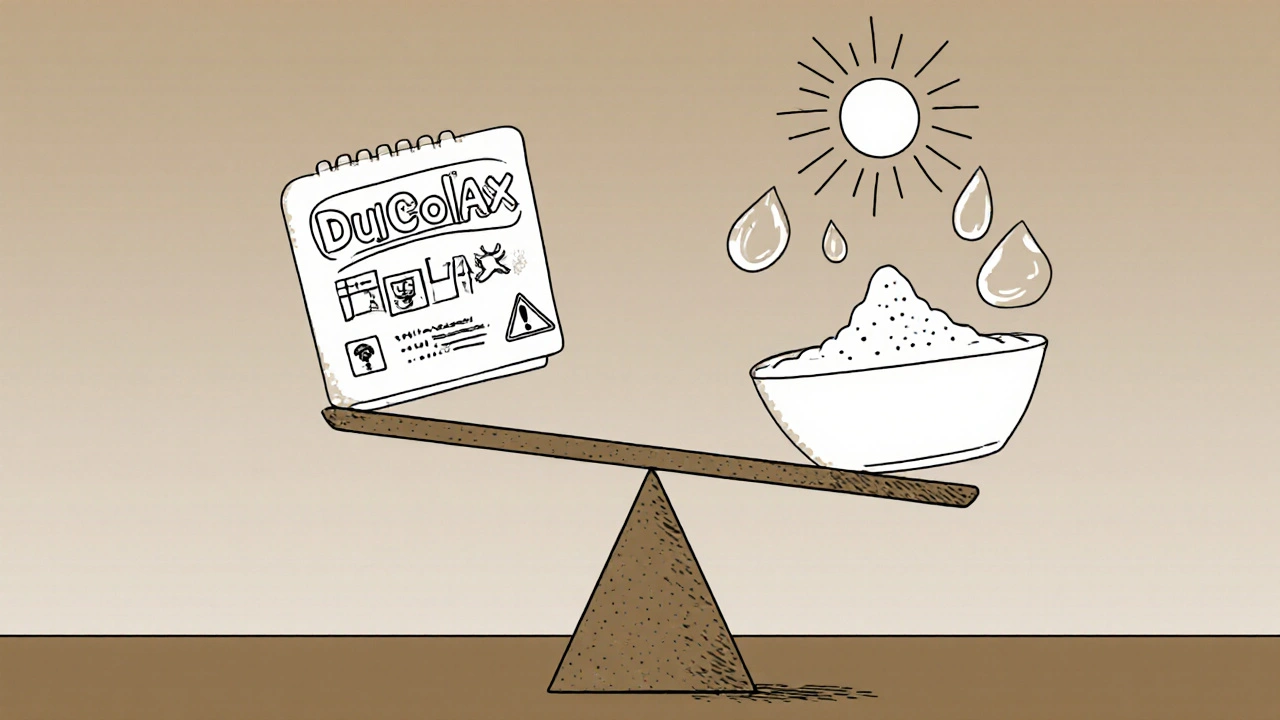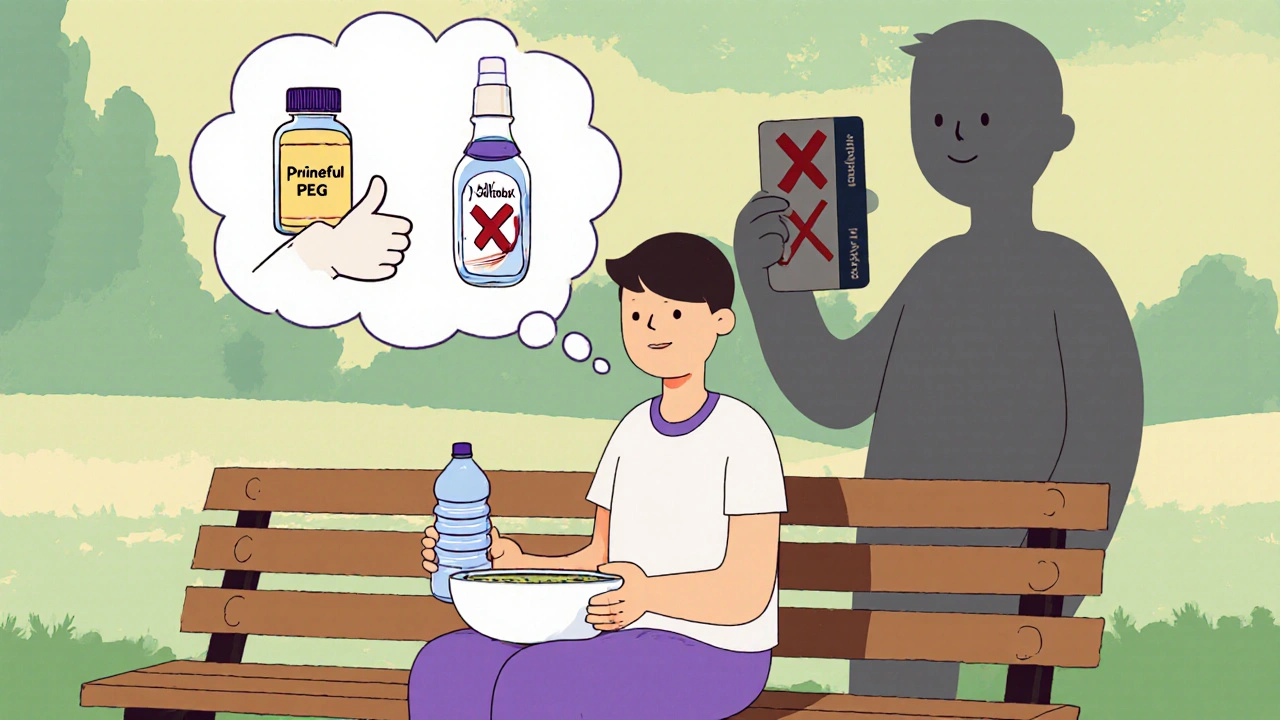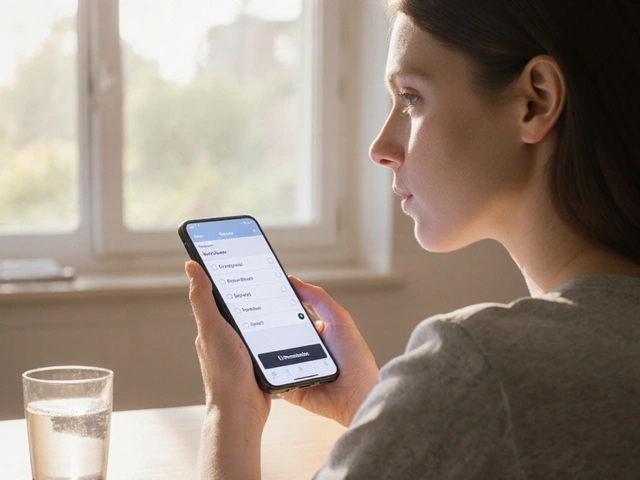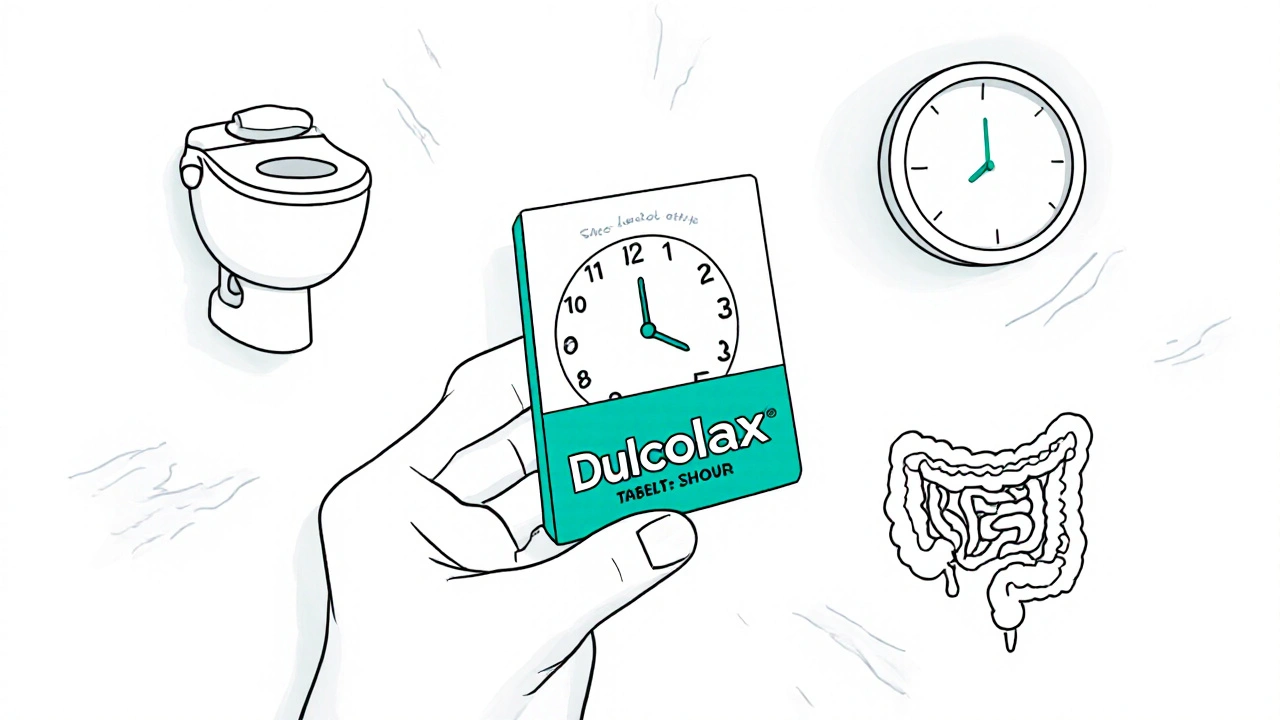Laxative Selection Tool
Select your situation
Your Best Laxative Options
Select your situation to see recommendations
Constipation doesn’t wait for a convenient time. It hits when you’re stuck in a meeting, traveling, or just trying to relax after a long day. If you’ve reached for Dulcolax (bisacodyl) before, you know it works fast-but is it the best choice? And what if it doesn’t work for you, or gives you cramps? There are other options, and not all of them are created equal. Let’s cut through the noise and compare Dulcolax with the most common alternatives, so you know exactly what to reach for next time.
What is Dulcolax (bisacodyl)?
Dulcolax is a brand name for bisacodyl, a stimulant laxative. It doesn’t soften stool or add bulk. Instead, it wakes up your colon. Bisacodyl triggers muscle contractions in the intestines, pushing waste out. Most people feel the effect within 6 to 12 hours after taking a tablet, and sometimes as fast as 15 to 60 minutes with suppositories.
It’s available as tablets, suppositories, and in some countries as a liquid. The standard tablet dose is 5 mg. Suppositories are often used when you need faster action or can’t swallow pills. It’s not a daily fix-it’s meant for occasional use. Long-term use can make your bowels lazy, leading to dependency.
How does bisacodyl compare to other laxatives?
Not all laxatives work the same way. They’re grouped by how they help you go. Here’s how bisacodyl stacks up against the most common alternatives:
1. Polyethylene glycol (PEG) - MiraLAX, Movicol
PEG is an osmotic laxative. It pulls water into the colon, softening stool and making it easier to pass. Unlike bisacodyl, it doesn’t irritate the bowel lining. People often find it gentler. It takes 1 to 3 days to work, so it’s not fast-but it’s reliable for longer-term use under medical supervision.
For chronic constipation, especially in older adults or people with IBS-C, PEG is often the first-line choice recommended by the British Society of Gastroenterology. It’s also safer for daily use than stimulant laxatives like bisacodyl.
2. Lactulose
Lactulose is another osmotic laxative, but it’s a synthetic sugar your body can’t digest. Gut bacteria ferment it, producing acids and gases that draw water into the colon. It usually takes 24 to 48 hours to work.
It’s commonly used in the UK for constipation in pregnancy and in elderly patients. Some people report bloating and gas with lactulose, which can be worse than with PEG. But it’s less likely to cause cramping than bisacodyl.
3. Senna - Senokot, Ex-Lax
Senna is also a stimulant laxative, like bisacodyl. It works by the same mechanism: irritating the colon lining to trigger contractions. Many people use senna because it’s cheaper and available over the counter without a brand name.
But here’s the catch: senna often causes more cramping than bisacodyl. Studies show that people taking senna report higher rates of abdominal pain and discomfort. Both can lead to dependency if used daily for more than a week. But bisacodyl tends to act faster and with slightly less irritation in some users.
4. Stool softeners - Docusate sodium (Colace)
Docusate sodium doesn’t make you poop. It makes your stool softer by letting water and fat mix into it. It’s great if you’re recovering from surgery, childbirth, or hemorrhoids and need to avoid straining. But it won’t help if your colon is just slow.
It takes 1 to 3 days to work. If you’re constipated and your stool is hard, docusate might help-but if you haven’t had a bowel movement in days, it probably won’t be enough on its own.
5. Magnesium hydroxide - Milk of Magnesia
This is an osmotic laxative that pulls water into the bowel and also has a mild stimulant effect. It usually works in 30 minutes to 6 hours. People like it because it’s fast and cheap.
But it can cause diarrhea if you take too much. It’s not ideal for people with kidney problems because magnesium builds up in the blood if your kidneys aren’t working well. If you’re on other meds, check with a pharmacist-magnesium can interfere with antibiotics and thyroid drugs.
When to choose Dulcolax (bisacodyl)
Dulcolax shines in three situations:
- You need a fast, predictable result-like before a medical procedure or travel.
- You’ve tried softer options (like PEG or docusate) and they didn’t work.
- You can’t tolerate the bloating from lactulose or the cramps from senna.
It’s the go-to for people who want control over timing. The suppository form is especially useful if you’re in pain or can’t swallow pills.
When to avoid bisacodyl
Dulcolax isn’t for everyone. Skip it if:
- You have abdominal pain, nausea, or vomiting-you could have a bowel obstruction.
- You’re pregnant or breastfeeding without checking with your doctor.
- You’ve been constipated for more than two weeks.
- You’ve used stimulant laxatives daily for more than a week.
- You have Crohn’s disease, ulcerative colitis, or a history of bowel surgery.
Using bisacodyl too often can lead to electrolyte imbalances, especially low potassium. That can cause muscle weakness or irregular heartbeat. It’s not dangerous in the short term, but it’s not harmless either.

Real-world advice from the UK
In NHS clinics and GP practices across England and Wales, the standard advice is clear: start with lifestyle changes. Drink more water, eat more fiber (whole grains, beans, vegetables), and move more. If that doesn’t help, try an osmotic laxative like PEG or lactulose first.
Stimulant laxatives like bisacodyl are reserved for when those don’t work-or when you need a quick fix. Pharmacists in Bristol, Manchester, or Edinburgh will often recommend PEG over Dulcolax for regular use because it’s gentler and safer long-term.
If you’re using Dulcolax more than twice a week, talk to your GP. There might be an underlying issue-like hypothyroidism, diabetes, or medication side effects-that’s causing the constipation.
What about natural options?
Prunes, figs, chia seeds, and flaxseed are often suggested as natural laxatives. They work because they’re high in fiber and some contain sorbitol, a natural osmotic agent. But they’re slow. You’d need to eat a lot-like 3-4 prunes daily-to match the effect of one tablet of PEG.
They’re great as a daily support, not as a rescue. Don’t rely on them if you’re in pain or need results within hours.
Final comparison table
| Laxative | Type | Time to Work | Best For | Common Side Effects |
|---|---|---|---|---|
| Dulcolax (bisacodyl) | Stimulant | 6-12 hours (tablet) 15-60 min (suppository) |
Fast relief, controlled timing | Cramps, bloating, dependency with long-term use |
| MiraLAX (PEG) | Osmotic | 1-3 days | Chronic constipation, elderly, pregnancy | Mild bloating, gas |
| Lactulose | Osmotic | 24-48 hours | Pregnancy, elderly, long-term use | Bloating, flatulence |
| Senna | Stimulant | 6-12 hours | Cheap, over-the-counter option | Strong cramps, dependency |
| Docusate sodium | Stool softener | 1-3 days | Post-surgery, hemorrhoids, avoiding straining | Minimal, but doesn’t fix slow bowels |
| Milk of Magnesia | Osmotic + mild stimulant | 30 min-6 hours | Fast relief, budget option | Diarrhea, electrolyte imbalance |

What to do if Dulcolax doesn’t work
If you take a Dulcolax tablet and nothing happens after 24 hours, don’t take another. You might have a blockage, or your body just doesn’t respond to stimulants. Try a PEG laxative instead. If that doesn’t work after two days, see your GP.
Also, don’t combine laxatives unless your doctor says so. Mixing bisacodyl with magnesium or senna increases the risk of dehydration and electrolyte loss.
When to see a doctor
Constipation isn’t always just a bowel issue. See a doctor if you have:
- Constipation lasting more than two weeks
- Blood in stool
- Unexplained weight loss
- Severe abdominal pain
- Change in bowel habits (especially if over 50)
- Need to use laxatives more than twice a week
These could signal something more serious-like colon cancer, thyroid problems, or nerve damage. Don’t ignore them.
Can I take Dulcolax every day?
No. Dulcolax is meant for occasional use. Taking it daily for more than a week can make your colon dependent on it to function. Your natural bowel movements may slow down over time. If you need daily relief, talk to your doctor about osmotic laxatives like PEG or lactulose, which are safer for long-term use.
Is Dulcolax safe during pregnancy?
Bisacodyl isn’t usually recommended during pregnancy unless other options have failed. Osmotic laxatives like PEG and lactulose are preferred because they don’t stimulate the bowel. Always check with your midwife or GP before taking any laxative while pregnant.
Which is better: Dulcolax tablets or suppositories?
Tablets work slower but are easier to take. Suppositories act faster-often within 15 to 60 minutes-and are better if you can’t swallow pills or need quick relief. But suppositories can cause more local irritation. Choose based on your needs: speed vs convenience.
Can I use Dulcolax with other medications?
Bisacodyl can interact with diuretics, heart medications (like digoxin), and corticosteroids because it can lower potassium levels. If you’re on any regular medication, ask your pharmacist before taking Dulcolax. Don’t combine it with other stimulant laxatives like senna.
Do laxatives cause weight loss?
No. Laxatives only remove water and stool-not fat. Any weight loss you see is temporary fluid loss. Using laxatives for weight control is dangerous and can lead to dehydration, electrolyte imbalances, and eating disorders. They are not a weight-loss tool.
Why does my stomach hurt after taking Dulcolax?
Bisacodyl stimulates your colon muscles, which can cause cramping. This is normal, but if the pain is severe or lasts longer than a few hours, stop using it. You might be sensitive to stimulant laxatives. Try switching to an osmotic laxative like PEG, which is gentler on the gut.
Next steps if you’re struggling with constipation
Start simple: drink more water-aim for 6 to 8 glasses a day. Add one extra serving of vegetables or whole grains to each meal. Walk for 20 minutes after dinner. These small changes often fix constipation without any pills.
If that doesn’t help, try PEG for 3-5 days. If you still don’t go, then consider Dulcolax as a short-term option. But don’t keep going back to it. Talk to your pharmacist or GP. There’s almost always a better, safer way to manage your bowels long-term.




Comments
12 Comments
Alexis Hernandez
Dulcolax saved my life during that business trip to Chicago. Suppository form? Absolute magic. Felt like a superhero by 9 AM. No more panic-poop in airport bathrooms. I swear by it now, but only when I absolutely need it. Don't let the haters scare you off.
brajagopal debbarma
Wow. So you wrote a whole essay on pooping. Did you get paid by Bayer? Or is this just your fanfic for bisacodyl? I take prunes. And I'm still alive. Maybe your colon just needs a vacation.
Carly Smith
I read this whole thing and still don't know what to take. Why do people make this so complicated? Just eat a damn prune. Or stop eating processed crap. I'm not paying $15 for a pill to fix my bad life choices.
Kurt Stallings
PEG is for the weak. If you need a laxative, you’ve already lost. Real men hold it. Or die trying. Also, lactulose tastes like regret.
Angie Creed
Let’s be honest - this entire post is a corporate marketing pamphlet disguised as medical advice. We’re not talking about constipation. We’re talking about capitalism’s colonization of our bowels. Who profits when we fear our own digestion? Dulcolax isn’t a solution - it’s a symptom.
Our colon is not a broken machine needing a stimulant. It’s a sacred temple of microbiome harmony, violated by sugar, stress, and sedentary Zoom meetings. We’ve been conditioned to fear the natural rhythm of our bodies. The real problem? We don’t live in alignment with the earth’s cycles anymore. We live in fluorescent-lit cubicles with zero sunlight and zero fiber. Fix that. Then you won’t need any of these pills.
And if you’re taking Dulcolax more than twice a month? You’re not constipated. You’re spiritually blocked.
Michael Ferguson
I’ve been using Dulcolax for 12 years now - every single morning, no exceptions. I’ve tried PEG, I’ve tried prunes, I’ve tried yoga, I’ve tried acupuncture, I’ve tried fasting, I’ve tried colonics, I’ve tried enemas, I’ve tried magnesium citrate, I’ve tried psyllium husk, I’ve tried apple cider vinegar, I’ve tried kombucha, I’ve tried probiotics, I’ve tried eating only raw vegetables for 30 days, I’ve tried drinking 3 liters of water before bed, I’ve tried lying on my left side while chanting mantras - nothing works like Dulcolax. My doctor says I’m dependent. I say I’m disciplined. My kidneys are fine. My electrolytes are fine. My bowels are fine. You’re just jealous because you can’t handle your own digestive responsibility. And if you’re telling me to ‘see a doctor’ after 2 weeks of constipation? That’s not medical advice - that’s a cry for help from someone who’s never actually held it in for more than 6 hours.
Also, I don’t eat fiber. I eat meat. And I poop like a champion. So your ‘eat more vegetables’ nonsense? It’s not science. It’s ideology.
Patrick Klepek
Man, I used to swear by Dulcolax until I started taking it every other day. Then I felt like my colon was on strike. Switched to PEG - took 3 days, but zero cramps. Felt like my gut was finally getting a hug instead of a slap. Honestly? This whole thread is a mess of extremes. Some people treat laxatives like magic wands. Others act like they’re poison. Truth is? It’s not about the pill. It’s about why you’re constipated in the first place. Maybe you’re stressed. Maybe you’re dehydrated. Maybe you’re sitting too much. The pill just hides the real problem. But hey - if Dulcolax gets you out the door on time? I’m not judging. Just don’t make it your lifestyle.
Caden Little
Hey everyone - just wanted to say you’re all doing great just by asking these questions! 💪
For anyone new to this: if you're unsure what to use, start with PEG (MiraLAX). It’s gentle, safe, and your gut won’t throw a tantrum. And if you’re worried about dependency? You’re not alone - that’s why so many of us panic when we skip a day. But here’s the truth: your body doesn’t forget how to poop. It just needs time and hydration to remember.
Drink water. Move your body. Add a banana or two. Try the PEG for 3 days. If nothing happens, then Dulcolax is totally fine as a one-time reset. But don’t make it your daily alarm clock. You got this! And if you need help figuring it out, your pharmacist is your best friend. Seriously - go talk to them. They’re awesome and don’t judge. 😊
Sebastian Brice
Look, I get it - Dulcolax is fast. But so is a slap on the face. Just because it gets results doesn’t mean it’s kind. I used to take it every time I felt ‘backed up’ - which was like, every other day. Then I realized I was training my body to need a chemical wake-up call just to function. That’s not health. That’s addiction with a prescription label.
Switched to PEG. Took a week to feel normal. Felt like my insides were finally relaxing. No cramps. No guilt. No shame. Just… regular. Like a normal human. And yeah, I still eat my prunes. Not because they’re magical - but because they remind me I’m not just a machine that needs a reset button.
Jim Aondongu
Dulcolax is fine if you are not weak. In Nigeria we just eat pap and beans and drink warm water and we are fine. Why you all need pills for everything. This is why your children are fat and weak. You are too soft. I take nothing. I go when I want. You need to be strong like African man. No pills no problem
Michael Schaller
I used to be the guy who took Dulcolax before every flight. Then I had a panic attack during a 3-hour delay and my stomach started cramping like I was being stabbed. Turns out I was dehydrated. And stressed. And eating too much airplane pretzels. I started drinking water like it was my job. Walked around the terminal. Ate an apple. And guess what? I pooped naturally. No pills. No panic. Just… me. Maybe we’re not broken. Maybe we’re just tired.
Kyle Tampier
THEY KNOW. THEY ALL KNOW. Dulcolax is a trap. The FDA, Big Pharma, the GPs - they’re all in on it. They want you dependent. They want you buying pills every month. PEG? It’s just a sugar-water placebo. Lactulose? It’s a slow poison disguised as ‘safe.’ The real solution? Cold exposure. Fasting. And avoiding EMFs from your phone. Your colon is being hacked by 5G. I’ve seen it. I’ve researched it. I stopped using all laxatives. I now meditate facing north at 4 AM. I pooped yesterday. No pills. No chemicals. Just pure cosmic alignment. You’re being lied to. Wake up.
Write a comment